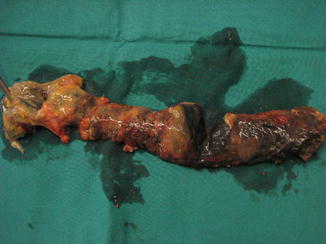Fig. 20.1
Mobilization of the distal pancreas and spleen
20.1.3 Maneuver 3: Pancreatic Head
Divide the lateral peritoneal attachment of the second part of the duodenum and mobilize the entire loop of the duodenum together with the head of the pancreas (Kocher’s maneuver) (Fig. 20.2). Mobilization should be wide, to the aorta in the retroperitoneum. Remember the most lateral structure in the porta hepatis is the common bile duct, which must be identified and protected with a wide Kocher maneuver.

Fig. 20.2
Kocher’s maneuver
Exposure can be considerably improved by freeing the hepatic flexure of the colon and extending the dissection to the loose avascular plane between the transverse colon and the proximal part of the transverse duodenum.
20.2 Pancreatic Necrosectomy
During the first 2 weeks into the disease process, extrapancreatic infections (bacteremia, pneumonia) are more common, whereas infected pancreatic necrosis peaks at 3–4 weeks. Fine-needle aspiration is no longer used for diagnosis of infected necrosis and has been replaced with signs of clinical deterioration, increase in C-reactive protein (CRP) level, worsening organ failure, and CT findings (gas bubbles). CT findings of peripancreatic collections associated with necrotizing pancreatitis include acute necrotic collection (ANC) and walled-off necrosis (WON). ANC is seen during the first 4 weeks, and it contains variable amount of fluid and necrotic tissue within or around the pancreas. WON is a mature encapsulated collection of pancreatic or peripancreatic necrosis with a well-defined enhancing inflammatory wall requiring usually more than 4 weeks to form.
The indications for (surgical, radiological, or endoscopic) intervention in necrotizing pancreatitis include:
Clinically suspected or documented infected necrosis with clinical deterioration or ongoing organ failure for several weeks
Ongoing gastric outlet, intestinal, or biliary obstruction due to mass effect of WON
Failure to thrive or progress: patient not getting better with WON but without infection (after 8 weeks)
Disconnected duct syndrome (full transection of the pancreatic duct) with persisting symptomatic collection with necrosis without signs of infection (>8 weeks)
Technique for open pancreatic necrosectomy:
Bilateral subcostal incision gives the easiest route to open pancreatic necrosectomy (technique described below), but other alternatives including the retroperitoneal approach and minimally invasive techniques can also be used.
Divide the gastrocolic ligament avoiding injury to the posterior wall of the stomach and the transverse colon, often adherent to the pancreas (or necrotic tissues) (maneuver 1).
Suck out the liquid secretions and pus in the lesser sac (bacterial specimens).
Extend the window to the patient’s left as much as needed to see the hilum of the spleen.
Scoop out the loose peripancreatic necrosis by blunt finger dissection exposing the transverse tentlike structure of the body and tail of the pancreas (which usually are viable and need not to be removed).
Occasionally, when faced with frank extended necrosis of the gland, removal of necrotic parts of the pancreas can result in near-to-total distal pancreatectomy.
Blunt dissection is usually sufficient without mobilizing or removing the spleen (Fig. 20.3).

Fig. 20.3
Necrotic distal pancreas removed during necrosectomy
If possible and identifiable, ligate the major pancreatic duct at the stump selectively (beware not to ligate the intrapancreatic part of the common bile duct in very proximal resections!).
Use a recent CT scan as a map to identify other areas of peripancreatic necrosis (usually on the right side behind the head of the pancreas and right hemicolon and on the left side behind the left hemicolon).
For additional exposure
On the left, mobilize the left hemicolon and create a plane between the descending colon anteriorly, and the left kidney and Gerota’s fascia posteriorly to connect to the lesser sac.
Stay updated, free articles. Join our Telegram channel

Full access? Get Clinical Tree







